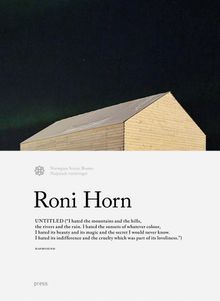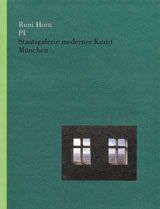| |||||||||||||||||||||||||||||||||||||||||||||
ARTIST MONOGRAPHS
|
|
STATUS: Forthcoming | 2/3/2026 This title is not yet published in the U.S. To pre-order or receive notice when the book is available, please email orders @ artbook.com |
 Roni Horn: A Dream Not Dreamt
Roni Horn: A Dream Not Dreamt
Published by Steidl.
Photographs by JJPhoto.
This artist's book weaves together multiple elements of New York-based artist Roni Horn's (born 1955) practice, including drawing, sculpture, photo installation and monologue. Sequenced by Horn herself, it commemorates her largest show to date at the HE Art Museum in Foshan, China.
PUBLISHER
Steidl
BOOK FORMAT
Hardcover, 7 x 9.25 in. / 168 pgs / 81 color.
PUBLISHING STATUS
Pub Date 7/15/2025
Active
DISTRIBUTION
D.A.P. Exclusive
Catalog: MID WINTER 2025 p. 31
PRODUCT DETAILS
ISBN 9783969993972 TRADE
List Price: $40.00 CAD $60.00
AVAILABILITY
In stock
in stock $40.00 Free Shipping UPS GROUND IN THE CONTINENTAL U.S. |
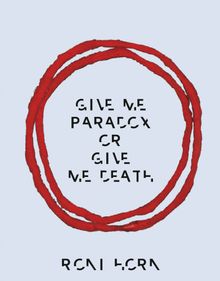 Roni Horn: Give Me Paradox or Give Me Death
Roni Horn: Give Me Paradox or Give Me Death
Published by Steidl/Museum Ludwig, Cologne.
Text by Yilmaz Dziewior, Zoë Lescaze, Andrew Maerkle, Isabel de Naverán, Kerstin Stakemeier.
Working across sculpture, photography, drawing and artist’s books, Roni Horn (born 1955) addresses identity, mutability and unease. The book’s title is transposed from Patrick Henry’s famous words: “Give me liberty, or give me death!” By replacing “liberty” with “paradox,” Horn nods to her interest in the reconciliation of two contradictory answers, an important aspect in her work, which also relates to her use of doubling or pairs. A seminal example of this is This Is Me, This Is You (1997–2000), photographs of the artist’s niece taken over a two-year period during her adolescence and presented on two opposite walls, or a.k.a. (2008–9), which captures the artist at different moments throughout her life. The catalog presents more than 100 works, including drawings from the late 1970s that have never been shown before, as well as a selection of pigment drawings made between 1983 and 2018.
PUBLISHER
Steidl/Museum Ludwig, Cologne
BOOK FORMAT
Hardcover, 8.5 x 10.75 in. / 312 pgs / 175 color.
PUBLISHING STATUS
Pub Date 7/2/2024
Active
DISTRIBUTION
D.A.P. Exclusive
Catalog: FALL 2024 p. 118
PRODUCT DETAILS
ISBN 9783969993798 TRADE
List Price: $60.00 CAD $87.50
AVAILABILITY
In stock
in stock $60.00 Free Shipping UPS GROUND IN THE CONTINENTAL U.S. |
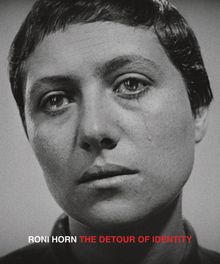 Roni Horn: The Detour of Identity
Roni Horn: The Detour of Identity
Published by Steidl.
Text by Roni Horn, Poul Erik Tøjner, Elisabeth Bronfen, Briony Fer, Gary Indiana.
Published to accompany the eponymous exhibition at the Louisiana Museum of Art, Humlebæk, Denmark, The Detour of Identity reads the work of Roni Horn (born 1955) through the prism of cinema, thereby revealing an intense psychosexuality that is often submerged under its empirical and conceptual character. Images of Horn’s photography, sculpture and drawing are presented alongside stills and excerpts from films by Robert Altman, Carl Theodor Dreyer, Rainer Werner Fassbinder, Alfred Hitchcock and Nicholas Roeg, among others. Essays by Louisiana Museum Director Poul Erik Tøjner, critic Elisabeth Bronfen, art historian Briony Fer and novelist Gary Indiana clarify the central importance of film to both the making and the understanding of Horn’s practice. Literature and language are often grasped as keys to Horn’s art, but by juxtaposing her work with film this book reveals that the body, desire, fantasy and sexuality are equally crucial to her exploration of identity.
PUBLISHER
Steidl
BOOK FORMAT
Clth, 10 x 12 in. / 488 pgs / 387 color / 152 bw.
PUBLISHING STATUS
Pub Date 10/29/2024
Active
DISTRIBUTION
D.A.P. Exclusive
Catalog: FALL 2024 p. 118
PRODUCT DETAILS
ISBN 9783969993781 TRADE
List Price: $85.00 CAD $125.00
AVAILABILITY
In stock
in stock $85.00 Free Shipping UPS GROUND IN THE CONTINENTAL U.S. |
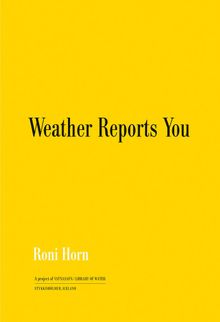 Roni Horn: Weather Reports You
Roni Horn: Weather Reports You
Published by Steidl/Artangel.
“Everyone has a story about the weather. This may be the single thing each of us holds in common. And though the weather varies greatly from here to there, it is, ultimately, one weather that we share. Small talk everywhere has occasioned the popular distribution of the weather. Some say talking about the weather is talking about oneself. And with each passing day, the weather increasingly becomes ours, if not us. Weather Reports You is one beginning of a collective self-portrait,” writes Roni Horn, “a metaphor for the physical, metaphysical, political, social and moral energy of a person and a place”.
This book is a new edition of the original Weather Reports You of 2007, a gathering of oral reports on the weather made on location in Iceland, accompanied by snapshots taken at the time and place of each interview.
PUBLISHER
Steidl/Artangel
BOOK FORMAT
Paperback, 5.5 x 8 in. / 200 pgs / 76 color.
PUBLISHING STATUS
Pub Date 1/10/2023
Active
DISTRIBUTION
D.A.P. Exclusive
Catalog: SPRING 2021 p. 116
PRODUCT DETAILS
ISBN 9783958299108 TRADE
List Price: $25.00 CAD $34.50
AVAILABILITY
In stock
in stock $25.00 Free Shipping UPS GROUND IN THE CONTINENTAL U.S. |
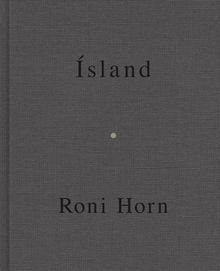 Roni Horn: Mother, Wonder
Roni Horn: Mother, Wonder
Published by Steidl.
In the south of Iceland is Landbrot, a place closer to fairy tales than to science—indeed, a place easy to imagine as the singular source of fairies and elves worldwide. It is easy, too, to imagine the sensual comfort and satisfaction to be found there. Mother, Wonder is the eleventh book in Roni Horn’s (born 1955) ongoing series To Place, which she initiated in 1989 and exists only in book form. All the volumes focus on Iceland and the evolving experiences of the artist there; together they form a flowing dialogue addressing the relationship between identity and place. The titles to date in the coveted To Place encyclopedia are Bluff Life (1990), Folds (1991), Lava (1992), Pooling Waters (1994), Verne’s Journey (1995), Haraldsdóttir (1996), Arctic Circles (1998), Becoming a Landscape (2001), Doubt Box (2006) and Haraldsdóttir, Part Two (2011).
PUBLISHER
Steidl
BOOK FORMAT
Clth, 8.25 x 10.25 in. / 80 pgs / 62 color.
PUBLISHING STATUS
Pub Date 6/13/2023
Active
DISTRIBUTION
D.A.P. Exclusive
Catalog: FALL 2023 p. 126
PRODUCT DETAILS
ISBN 9783969991855 TRADE
List Price: $85.00 CAD $125.00
AVAILABILITY
In stock
in stock $85.00 Free Shipping UPS GROUND IN THE CONTINENTAL U.S. |
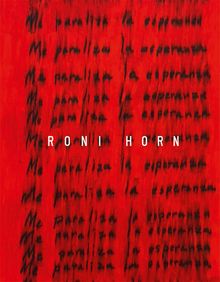 Roni Horn: I Am Paralyzed with Hope
Roni Horn: I Am Paralyzed with Hope
Published by La Fábrica.
Text by Carmen Maria Machado, Isabel de Naverán, Bárbara Rodríguez.
This artist's book compiles a selection of work by Roni Horn (born 1955), whose diverse practice spans photography, sculpture, drawing and conceptually oriented book projects. The book includes a text by American writer Carmen Maria Machado and an interview with the artist.
PUBLISHER
La Fábrica
BOOK FORMAT
Hardcover, 9.5 x 12 in. / 186 pgs / 70 color.
PUBLISHING STATUS
Pub Date 10/3/2023
Out of stock indefinitely
DISTRIBUTION
D.A.P. Exclusive
Catalog: FALL 2023 p. 163
PRODUCT DETAILS
ISBN 9788418934674 TRADE
List Price: $40.00 CAD $58.00 GBP £35.00
AVAILABILITY
Not available
STATUS: Out of stock indefinitely. |
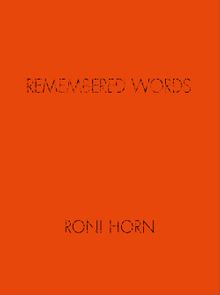 Roni Horn: Remembered Words
Roni Horn: Remembered Words
Published by SteidlDangin.
PUBLISHER
SteidlDangin
BOOK FORMAT
Clth, 9.5 x 12.75 in. / 344 pgs / 296 color.
PUBLISHING STATUS
Pub Date 5/31/2022
Active
DISTRIBUTION
D.A.P. Exclusive
Catalog: FALL 2015 p. 141
PRODUCT DETAILS
ISBN 9783869309965 TRADE
List Price: $85.00 CAD $117.00
AVAILABILITY
In stock
in stock $85.00 Free Shipping UPS GROUND IN THE CONTINENTAL U.S. |
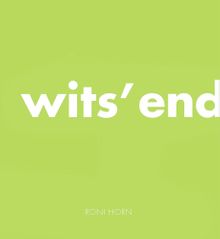 Roni Horn: Wits' End
Roni Horn: Wits' End
Published by Hauser & Wirth Publishers.
Text by Michelle White.
In the two series of drawings that comprise Wits’ End, Roni Horn (born 1955) takes handwritten idioms, clichés and colloquialisms as her source material. Horn asked approximately 300 people to write down five of these vernacular phrases, which were then made into individual silkscreens. In Wits’ End Sampler (2018), shown at the Menil Drawing Institute in Houston, Texas, in 2018–19, the idioms are screened in a unique configuration directly on the wall; Wits End Mash (2019) consists of compositions of 75 to 350 idioms silkscreened on paper.
These drawings engage the “moments when language fails and connotation migrates,” with meaning that “delights in instability and movement,” as Michelle White writes in her essay included in this volume.
Wits’ End is the seventh in a series of books by Horn gathering series of works, two of which—bird (2008) and aka (2010)—were published by Hauser & Wirth Publishers.
PUBLISHER
Hauser & Wirth Publishers
BOOK FORMAT
Hardcover, 11 x 12 in. / 120 pgs / 52 color.
PUBLISHING STATUS
Pub Date 11/23/2021
Active
DISTRIBUTION
D.A.P. Exclusive
Catalog: SPRING 2022 p. 34
PRODUCT DETAILS
ISBN 9783906915654 TRADE
List Price: $45.00 CAD $61.50
AVAILABILITY
In stock
in stock $45.00 Free Shipping UPS GROUND IN THE CONTINENTAL U.S. |
 Roni Horn: Remembered Words, A Specimen Concordance
Roni Horn: Remembered Words, A Specimen Concordance
Published by Steidl.
This publication alphabetizes and enumerates each word used in the 370 drawings made by American artist Roni Horn (born 1955) for Remembered Words (2012–13), a series of watercolor paintings punctuated by words recalled, without preference or hierarchy, from life experience.
PUBLISHER
Steidl
BOOK FORMAT
Paperback, 6 x 8 in. / 88 pgs / illustrated throughout.
PUBLISHING STATUS
Pub Date 4/23/2019
Active
DISTRIBUTION
D.A.P. Exclusive
Catalog: SPRING 2019 p. 194
PRODUCT DETAILS
ISBN 9783958295643 FLAT40
List Price: $25.00 CAD $34.95
AVAILABILITY
In stock
in stock $25.00 Free Shipping UPS GROUND IN THE CONTINENTAL U.S. |
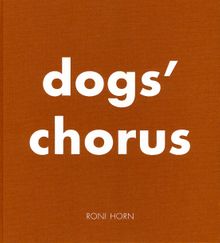 Roni Horn: Dogs' Chorus
Roni Horn: Dogs' Chorus
Published by Steidl.
Text by Briony Fer.
Dogs' Chorus presents a group of recent drawings by Roni Horn (born 1955). Following up on Th Rose Prblm (2016), Horn cuts apart original drawings of texts and reassembles them into compositions that are cumulative and complex. Here, Horn combines a line from Shakespeare’s Julius Caesar with common idioms.
PUBLISHER
Steidl
BOOK FORMAT
Clth, 11.25 x 12.25 in. / 86 pgs, gatefolds / 30 color.
PUBLISHING STATUS
Pub Date 5/21/2019
Active
DISTRIBUTION
D.A.P. Exclusive
Catalog: SPRING 2019 p. 34
PRODUCT DETAILS
ISBN 9783958295360 FLAT40
List Price: $60.00 CAD $85.00
AVAILABILITY
In stock
in stock $60.00 Free Shipping UPS GROUND IN THE CONTINENTAL U.S. |
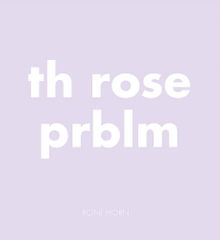 Roni Horn: Th Rose Prblm
Roni Horn: Th Rose Prblm
Published by Steidl.
PUBLISHER
Steidl
BOOK FORMAT
Clth, 11.25 x 12.25 in. / 80 pgs / 49 color.
PUBLISHING STATUS
Pub Date 3/28/2017
Active
DISTRIBUTION
D.A.P. Exclusive
Catalog: SPRING 2017 p. 152
PRODUCT DETAILS
ISBN 9783958292710 FLAT40
List Price: $40.00 CAD $54.00
AVAILABILITY
In stock
in stock $40.00 Free Shipping UPS GROUND IN THE CONTINENTAL U.S. |
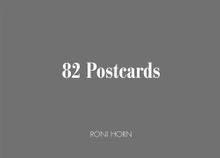 Roni Horn: 82 Postcards
Roni Horn: 82 Postcards
Published by Hauser & Wirth Publishers.
Her translation of these mementos—mostly from North America, but some from farther afield—lays bare the interplay of their various parts, questioning how pieces of content come together to form the basis of complex cultural phenomena like tourist attractions, popular science and national identity.
PUBLISHER
Hauser & Wirth Publishers
BOOK FORMAT
Paperback, 7 x 5 in. / 168 pgs / 1 color.
PUBLISHING STATUS
Pub Date 5/23/2017
Active
DISTRIBUTION
D.A.P. Exclusive
Catalog: FALL 2017 p. 148
PRODUCT DETAILS
ISBN 9783952446164 TRADE
List Price: $45.00 CAD $60.00
AVAILABILITY
In stock
in stock $45.00 Free Shipping UPS GROUND IN THE CONTINENTAL U.S. |
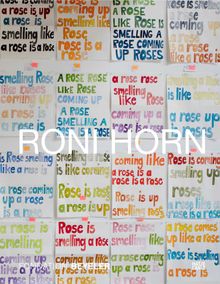 Roni Horn
Roni Horn
Published by Hatje Cantz.
Edited with text by Riehen/Basel, Theodora Vischer.
PUBLISHER
Hatje Cantz
BOOK FORMAT
Paperback, 11.5 x 13 in. / 32 pgs / 25 color.
PUBLISHING STATUS
Pub Date 2/28/2017
Out of stock indefinitely
DISTRIBUTION
D.A.P. Exclusive
Catalog: SPRING 2017 p. 152
PRODUCT DETAILS
ISBN 9783775742511 FLAT40
List Price: $15.00 CAD $21.50
AVAILABILITY
Not available
STATUS: Out of stock indefinitely. |
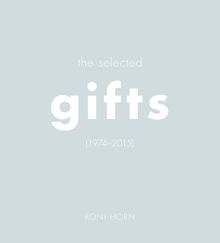 Roni Horn: The Selected Gifts (1974–2015)
Roni Horn: The Selected Gifts (1974–2015)
Published by Steidl.
PUBLISHER
Steidl
BOOK FORMAT
Hardcover, 11 x 12 in. / 120 pgs / 67 color.
PUBLISHING STATUS
Pub Date 6/14/2016
Active
DISTRIBUTION
D.A.P. Exclusive
Catalog: FALL 2016 p. 171
PRODUCT DETAILS
ISBN 9783958291621 FLAT40
List Price: $45.00 CAD $60.00
AVAILABILITY
In stock
in stock $45.00 Free Shipping UPS GROUND IN THE CONTINENTAL U.S. |
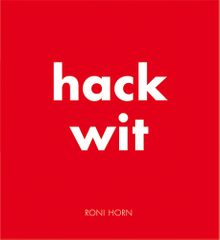 Roni Horn: Hack Wit
Roni Horn: Hack Wit
Published by Steidl.
Text by Anne Carson.
PUBLISHER
Steidl
BOOK FORMAT
Clth, 11.25 x 12 in. / 104 pgs / 55 color.
PUBLISHING STATUS
Pub Date 9/29/2015
Active
DISTRIBUTION
D.A.P. Exclusive
Catalog: FALL 2015 p. 141
PRODUCT DETAILS
ISBN 9783869309828 TRADE
List Price: $60.00 CAD $79.00
AVAILABILITY
In stock
in stock $60.00 Free Shipping UPS GROUND IN THE CONTINENTAL U.S. |
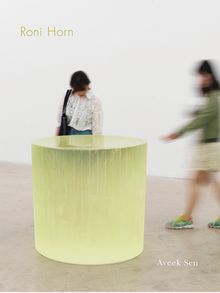 Roni Horn: The Sensation of Sadness at Having Slept Through a Shower of Meteors
Roni Horn: The Sensation of Sadness at Having Slept Through a Shower of Meteors
Published by Kukje Gallery.
Edited with text by Aveek Sen.
PUBLISHER
Kukje Gallery
BOOK FORMAT
Paperback, 6.5 x 8.5 in. / 70 pgs / 22 color.
PUBLISHING STATUS
Pub Date 6/23/2015
Out of stock indefinitely
DISTRIBUTION
D.A.P. Exclusive
Catalog: FALL 2015 p. 141
PRODUCT DETAILS
ISBN 9780983446576 TRADE
List Price: $29.95 CAD $39.95 GBP £27.00
AVAILABILITY
Not available
STATUS: Out of stock indefinitely. |
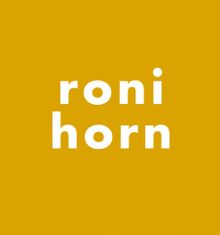 Roni Horn: Everything Was Sleeping as if the Universe Were a Mistake
Roni Horn: Everything Was Sleeping as if the Universe Were a Mistake
Published by Turner.
Interview by Julie Ault.
PUBLISHER
Turner
BOOK FORMAT
Hardcover, 11 x 12 in. / 154 pgs / 100 color.
PUBLISHING STATUS
Pub Date 12/31/2014
Out of print
DISTRIBUTION
D.A.P. Exclusive
Catalog: FALL 2014 p. 133
PRODUCT DETAILS
ISBN 9788415832522 TRADE
List Price: $40.00 CAD $54.00
AVAILABILITY
Not available
STATUS: Out of print | 00/00/00 For assistance locating a copy, please see our list of recommended out of print specialists |
Roni Horn: Haraldsdottir Part Two, Limited Edition
Published by Steidl.
PUBLISHER
Steidl
BOOK FORMAT
Clth, 9 x 11 in. / 144 pgs / illustrated throughout.
PUBLISHING STATUS
Pub Date 10/15/2013
Out of stock indefinitely
DISTRIBUTION
D.A.P. Exclusive
Catalog: FALL 2014
PRODUCT DETAILS
ISBN 9783869304298 TRADE
List Price: $420.00 CAD $510.00
AVAILABILITY
Not available
STATUS: Out of stock indefinitely. |
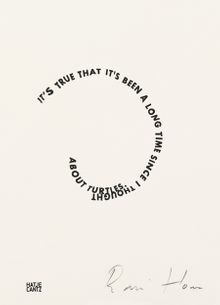 Roni Horn
Roni Horn
Published by Hatje Cantz.
Edited by Ingvild Goetz, Larissa Michelberger, Rainald Schumacher. Text by Kirsty Bell, Ingvild Goetz, Roni Horn, Christy Lange, James Lingwood, Rainald Schumacher, Aveek Sen.
PUBLISHER
Hatje Cantz
BOOK FORMAT
Hardcover, 7 x 9.75 in. / 216 pgs / 127 color.
PUBLISHING STATUS
Pub Date 8/31/2013
Out of print
DISTRIBUTION
D.A.P. Exclusive
Catalog: FALL 2013 p. 124
PRODUCT DETAILS
ISBN 9783775735643 TRADE
List Price: $55.00 CAD $72.50
AVAILABILITY
Not available
STATUS: Out of print | 00/00/00 For assistance locating a copy, please see our list of recommended out of print specialists |
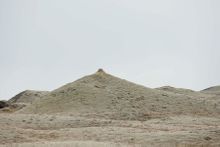 Roni Horn: Artist's Portfolio
Roni Horn: Artist's Portfolio
Published by La Fábrica.
PUBLISHER
La Fábrica
BOOK FORMAT
Paperback, 11.75 x 15.75 in. / 24 pgs / illustrated throughout.
PUBLISHING STATUS
Pub Date 4/30/2013
Out of print
DISTRIBUTION
D.A.P. Exclusive
Catalog: SPRING 2013 p. 177
PRODUCT DETAILS
ISBN 9788415691044 TRADE
List Price: $65.00 CAD $87.00 GBP £56.00
AVAILABILITY
Not available
STATUS: Out of print | 00/00/00 For assistance locating a copy, please see our list of recommended out of print specialists |
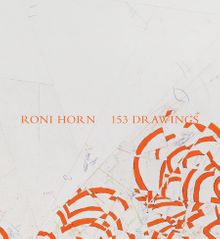 Roni Horn: 153 Drawings
Roni Horn: 153 Drawings
Published by JRP|Ringier.
Edited by Michaela Unterdörfer. Text by Tacita Dean, Briony Fer.
PUBLISHER
JRP|Ringier
BOOK FORMAT
Clth, 11 x 12 in. / 324 pgs / 153 color.
PUBLISHING STATUS
Pub Date 4/30/2013
Out of print
DISTRIBUTION
D.A.P. Exclusive
Catalog: SPRING 2013 p. 107
PRODUCT DETAILS
ISBN 9783037643051 TRADE
List Price: $80.00 CAD $107.50
AVAILABILITY
Not available
STATUS: Out of print | 00/00/00 For assistance locating a copy, please see our list of recommended out of print specialists |
Roni Horn: Haraldsdóttir, Part Two
Published by Steidl.
PUBLISHER
Steidl
BOOK FORMAT
Clth, 8.25 x 11.25 in. / 144 pgs / illustrated throughout.
PUBLISHING STATUS
Pub Date 3/16/2012
Out of print
DISTRIBUTION
D.A.P. Exclusive
Catalog: FALL 2014
PRODUCT DETAILS
ISBN 9783869303178 TRADE
List Price: $90.00 CAD $110.00
AVAILABILITY
Not available
STATUS: Out of print | 00/00/00 For assistance locating a copy, please see our list of recommended out of print specialists |
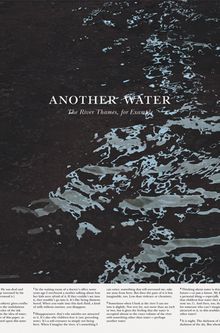 Roni Horn: Another Water
Roni Horn: Another Water
Published by Steidl.
In 2000 Roni Horn published Another Water, an examination of the water of the River Thames through extensively footnoted photographs. This new edition of Another Water includes a new edit of the photographic aspect of the work. Water is a central theme for Horn: as a component of weather, a defining feature of her beloved Iceland, and as a beautiful, changeable element on which life depends. Another Water is an ode to the substance of water but also to its impact on identity and imagination--in Horn's words, "You can't talk about water without talking about oneself."
PUBLISHER
Steidl
BOOK FORMAT
Paperback, 7.7 x 12 in. / 112 pgs / illustrated throughout.
PUBLISHING STATUS
Pub Date 9/15/2011
Out of print
DISTRIBUTION
D.A.P. Exclusive
Catalog: FALL 2014
PRODUCT DETAILS
ISBN 9783869303185 TRADE
List Price: $45.00 CAD $60.00
AVAILABILITY
Not available
STATUS: Out of print | 00/00/00 For assistance locating a copy, please see our list of recommended out of print specialists |
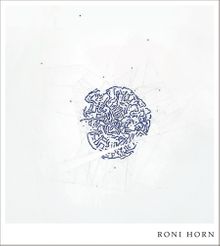 Roni Horn
Roni Horn
Published by Kukje Gallery.
Text by Elisabeth Lebovici.
PUBLISHER
Kukje Gallery
BOOK FORMAT
Clth, 10.5 x 12 in. / 135 pgs / illustrated throughout.
PUBLISHING STATUS
Pub Date 5/31/2011
Out of print
DISTRIBUTION
D.A.P. Exclusive
Catalog: SPRING 2011 p. 84
PRODUCT DETAILS
ISBN 9788992233439 TRADE
List Price: $50.00 CAD $60.00
AVAILABILITY
Not available
STATUS: Out of print | 00/00/00 For assistance locating a copy, please see our list of recommended out of print specialists |
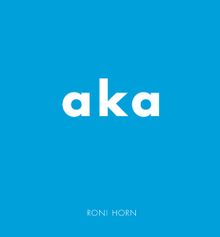 Roni Horn: aka
Roni Horn: aka
Published by Steidl.
PUBLISHER
Steidl
BOOK FORMAT
Clth, 11 x 12 in. / 42 pgs / illustrated throughout.
PUBLISHING STATUS
Pub Date 6/1/2010
Active
DISTRIBUTION
D.A.P. Exclusive
Catalog: FALL 2014
PRODUCT DETAILS
ISBN 9783869301334 TRADE
List Price: $60.00 CAD $79.00
AVAILABILITY
In stock
in stock $60.00 Free Shipping UPS GROUND IN THE CONTINENTAL U.S. |
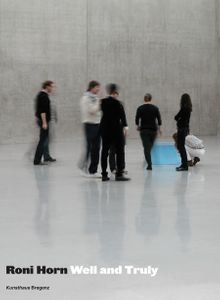 Roni Horn: Well and Truly
Roni Horn: Well and Truly
Published by Kunsthaus Bregenz.
Edited by Yilmaz Dziewior. Text by Gary Indiana, Julie Ault.
PUBLISHER
Kunsthaus Bregenz
BOOK FORMAT
Hardcover, 8.75 x 12 in. / 96 pgs / 60 color.
PUBLISHING STATUS
Pub Date 10/31/2010
Out of print
DISTRIBUTION
D.A.P. Exclusive
Catalog: SPRING 2011 p. 84
PRODUCT DETAILS
ISBN 9783865608161 TRADE
List Price: $55.00 CAD $65.00
AVAILABILITY
Not available
STATUS: Out of print | 00/00/00 For assistance locating a copy, please see our list of recommended out of print specialists |
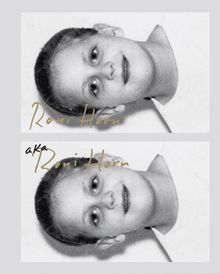 Roni Horn aka Roni Horn
Roni Horn aka Roni Horn
Published by Steidl & Partners.
Introduction by Donna De Salvo, Carter E. Foster, Mark Godfrey. Text by Briony Fer.
Born in New York in 1955, Roni Horn achieved international recognition in the 1980s, and her works have been the subject of numerous major exhibitions since. In 2007, she undertook Artangel's first international commission, creating Vatnasafn/Library of Water, a long-term installation in the town of Stykkisholmur, Iceland. She has had solo exhibitions at numerous leading art institutions, including Inverleith House, Edinburgh (2006), Fotomuseum Winterthur (2003), The Art Institute of Chicago (2004), Folkwang Museum, Essen (2004), Centre Pompidou, Paris (2003), Dia Center for the Arts, New York (2001-02) and Museo Serralves, Porto (2001).
PUBLISHER
Steidl & Partners
BOOK FORMAT
Slip, Hardcover, 2 vols, 7.75 x 9.75 in. / 430 pgs / 375 color.
PUBLISHING STATUS
Pub Date 5/31/2009
Out of print
DISTRIBUTION
D.A.P. Exclusive
Catalog: SPRING 2009 p. 86
PRODUCT DETAILS
ISBN 9783865218315 TRADE
List Price: $70.00 CAD $92.50
AVAILABILITY
Not available
STATUS: Out of print | 00/00/00 For assistance locating a copy, please see our list of recommended out of print specialists |
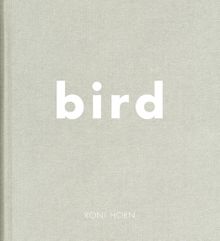 Roni Horn: Bird
Roni Horn: Bird
Published by Steidl/Hauser & Wirth.
Text by Philip Larratt-Smith.
Roni Horn was born in 1955 in New York, where she continues to live and work. Since earning her MFA from Yale University in 1978, she has shown her sculptures, installations and photographs extensively throughout the world. She has had solo exhibitions at the Dia Center for the Arts, the Whitney Museum of American Art and the Centre Pompidou in Paris, and her work will be the subject of a major retrospective at the Whitney Museum of American Art in 2009.
PUBLISHER
Steidl/Hauser & Wirth
BOOK FORMAT
Hardback, 11 x 12 in. / 36 pgs / 20 color.
PUBLISHING STATUS
Pub Date 9/1/2008
Out of stock indefinitely
DISTRIBUTION
D.A.P. Exclusive
Catalog: FALL 2008 p. 75
PRODUCT DETAILS
ISBN 9783865216694 TRADE
List Price: $50.00 CAD $67.50
AVAILABILITY
Not available
STATUS: Out of stock indefinitely. |
 Roni Horn: Herdubreid at Home
Roni Horn: Herdubreid at Home
Published by Steidl.
PUBLISHER
Steidl
BOOK FORMAT
Paperback, 6 x 8.5 in. / 120 pgs / 60 color.
PUBLISHING STATUS
Pub Date 11/1/2007
Active
DISTRIBUTION
D.A.P. Exclusive
Catalog: FALL 2007 p. 142
PRODUCT DETAILS
ISBN 9783865214577 TRADE
List Price: $20.00 CAD $27.95
AVAILABILITY
In stock
in stock $20.00 Free Shipping UPS GROUND IN THE CONTINENTAL U.S. |
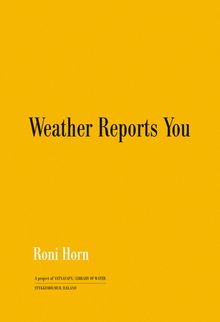 Roni Horn: Weather Reports You
Roni Horn: Weather Reports You
Published by Steidl/Artangel.
Introduction by Roni Horn.
PUBLISHER
Steidl/Artangel
BOOK FORMAT
Paperback, 5.5 x 8 in. / 196 pgs / 100 color.
PUBLISHING STATUS
Pub Date 7/1/2007
Out of print
DISTRIBUTION
D.A.P. Exclusive
Catalog: SPRING 2007 p. 72
PRODUCT DETAILS
ISBN 9783865213884 TRADE
List Price: $45.00 CAD $60.00
AVAILABILITY
Not available
STATUS: Out of print | 00/00/00 For assistance locating a copy, please see our list of recommended out of print specialists |
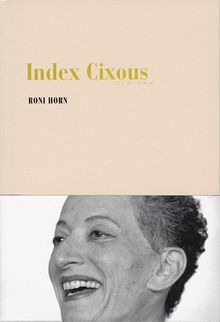 Roni Horn: Index Cixous, 2003-05
Roni Horn: Index Cixous, 2003-05
Published by Steidl.
Artwork by Roni Horn. Text by Dave Hickey.
PUBLISHER
Steidl
BOOK FORMAT
Paperback, 5.5 x 8 in. / 120 pgs / 15 color / 65 tritone.
PUBLISHING STATUS
Pub Date 12/15/2005
Active
DISTRIBUTION
D.A.P. Exclusive
Catalog: FALL 2005 p. 133
PRODUCT DETAILS
ISBN 9783865211354 TRADE
List Price: $20.00 CAD $27.95
AVAILABILITY
In stock
in stock $20.00 Free Shipping UPS GROUND IN THE CONTINENTAL U.S. |
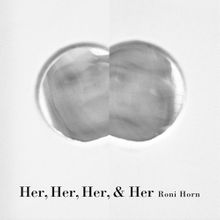 Roni Horn: Her, Her, Her And Her
Roni Horn: Her, Her, Her And Her
Published by Steidl/Dangin.
Artwork by Roni Horn.
PUBLISHER
Steidl/Dangin
BOOK FORMAT
Paperback, 9.5 x 9.5 in. / 128 pgs / 120 duotone.
PUBLISHING STATUS
Pub Date 11/2/2004
Active
DISTRIBUTION
D.A.P. Exclusive
Catalog: FALL 2004
PRODUCT DETAILS
ISBN 9783865210357 TRADE
List Price: $40.00 CAD $54.00
AVAILABILITY
In stock
in stock $40.00 Free Shipping UPS GROUND IN THE CONTINENTAL U.S. |
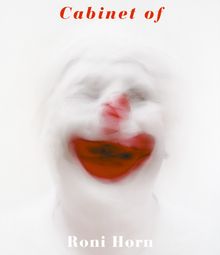 Roni Horn: Cabinet Of
Roni Horn: Cabinet Of
Published by Steidl.
Artwork by Roni Horn.
PUBLISHER
Steidl
BOOK FORMAT
Hardcover, 12 x 14 in. / 76 pgs / 36 color.
PUBLISHING STATUS
Pub Date 5/2/2003
Active
DISTRIBUTION
D.A.P. Exclusive
Catalog: SPRING 2003
PRODUCT DETAILS
ISBN 9783882438642 TRADE
List Price: $85.00 CAD $112.50
AVAILABILITY
In stock
in stock $85.00 Free Shipping UPS GROUND IN THE CONTINENTAL U.S. |
PUBLISHER
Hatje Cantz
BOOK FORMAT
Paperback, 6.5 x 8.25 in. / 128 pgs / 46 color
PUBLISHING STATUS
Pub Date 4/2/2000
Out of print
DISTRIBUTION
D.A.P. Exclusive
Catalog: SPRING 2000
PRODUCT DETAILS
ISBN 9783775709125 TRADE
List Price: $14.95 CAD $17.50
AVAILABILITY
Not available
STATUS: Out of print | 6/1/2001 For assistance locating a copy, please see our list of recommended out of print specialists |
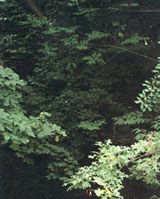 Roni Horn: Earth Grows Thick
Roni Horn: Earth Grows Thick
Published by Wexner Center for the Arts.
Contributions by Amada Cruz. Text by bell hooks.
PUBLISHER
Wexner Center for the Arts
BOOK FORMAT
Paperback, 10.25 x 8.25 in. / 104 pgs / 20 color / 12 duotone.
PUBLISHING STATUS
Pub Date 1/2/1996
Out of print
DISTRIBUTION
D.A.P. Exclusive
Catalog: SPRING 1996
PRODUCT DETAILS
ISBN 9781881390121 TRADE
List Price: $42.95 CAD $50.00
AVAILABILITY
Not available
STATUS: Out of print | 11/28/2010 For assistance locating a copy, please see our list of recommended out of print specialists |
